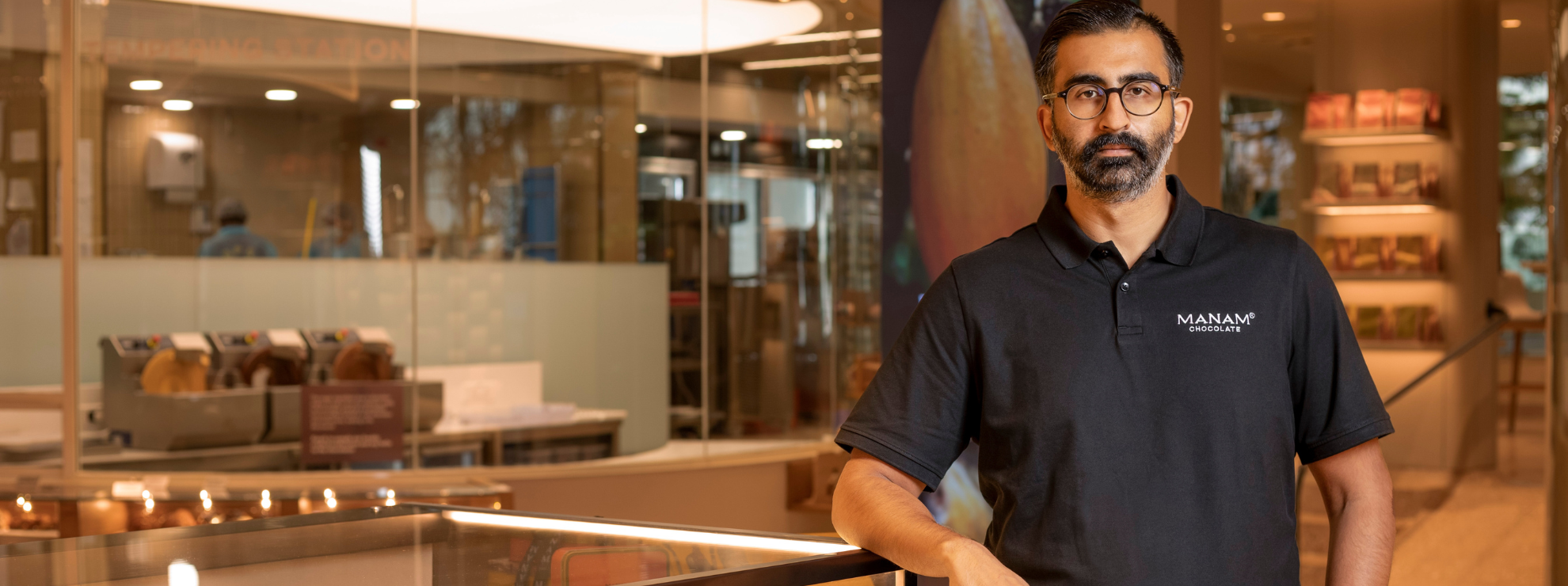(September 1, 2024) Chaitanya Muppala has tasted success quite early in his career. Literally. What else would you say when the craft chocolate brand he launches, wins several awards within four months of hitting the market? A first-generation chocolate taster and a second-generation entrepreneur, he is the CEO of Distinct Origins Private Limited (DOPL) which launched Manam Chocolate [Manam meaning us in Telugu], an Indian craft chocolate brand that operates in the emerging speciality chocolate market in the country. Within four months of its launch, Manam Chocolate went on to win in 17 categories at the World Chocolate Awards.
He had the advantage of a decade of experience in the food business by running and upscaling Almond House, the well-known Indian mithai chain in Hyderabad, started by his father in 1989. He is a graduate of the prestigious Sauder School of Business, University of British Columbia, Canada, after which he joined the family business. Chaitanya was part of the Stanford Seed Programme from the Stanford University Graduate School of Business’ Institute for Innovation in Developing Economies. After joining Almond House, he has been instrumental in the creation of distinct brands including Indulge ice cream, an all-natural gourmet ice cream range, Gappe Vappe Chaatwala, Amande by Almond House, that makes 100 per cent eggless, premium bakery products, and Greater Gud, an FMCG brand focussing on the goodness of jaggery.

Chocolates Are Us
How did the shift towards chocolate happen, we ask? Seated in the spacious environs of the café at Manam Chocolate Karkhana, which houses the store above, and surrounded by the aromas of freshly made chocolate, Chaitanya tells Global Indian, “When it comes to quality Indian chocolate, I observed that everyone was using the same raw materials and the same homogenous product was being made. It was more an industrial grade that was available. In keeping with the global movement of making craft chocolate, I did my research.” That meant exploring the cacao growing regions in West Godavari for three years, during which time he talked to farmers and learned of their positive and meaningful impact on the value chain. “I also got to know about the technical problems they faced in the drying and fermenting of the cacao beans. Though India has been growing cacao since the 1960s, we are an industrial player and not in the business of craft chocolate,” he says.
His thorough research led to the setting up of his company Distinct Origins P/L to establish the West Godavari region as a place of origin from where potential global craft chocolate makers could import fine-flavour cacao beans; and local players could create Indian craft chocolate, like Manam Chocolate. He streamlined the entire process of the bean to its finished product with proprietary technology and software to the extent that he knows which bean comes from which tree, belongs to which farm and the farmer cultivating it. The packaging includes a picture of the farmer growing the bean in the single farmer series of chocolate.
The Science of Chocolate
Chaitanya is one of those entrepreneurs who will go the last mile to ensure perfection. Besides making the cultivating and sourcing process tech-driven, he set up India’s largest fermentery – the Distinct Origins Cacao Fermentery in Tadikalapudi, West Godavari, Andhra Pradesh. It is the largest of its kind in India, and estimated to be second largest in the world, a state-of-the-art cacao processing facility situated amidst their 150 partner farms.
The protocols followed at the cacao fermentery include stringent cacao screening, where only the finest pods are selected, and wooden clubs are used to crack them open, instead of machetes and sickles. This is done to protect the beans within from damage. After the selection, the beans go through a five-step fermentation process, and the proprietary technology monitors parameters such as pH levels, temperature, humidity etc. This is followed by a slow drying method on movable racks that are kept alternatively in the sun and the shade, and the beans are turned every hour by hand to ensure even drying.

The ‘Indulge’ collection by Manam Chocolates. Photo courtesy: Daniel D’Souza
After the sorting, weighing, labelling etc., the beans come to the Manam Chocolate Karkhana, the company’s first retail-cum-experiential concept store, where the chocolate is made. They offer a guided tour experience and workshops for anyone interested and you can see first-hand the chocolate being made. The display houses the varieties available which include, tablets, further divided into categories like single farm, single origin India and international, dark, milk and vegan as well as signature blends and infusions etc. Lovers of chocolate can choose from bonbons, thins, and more. Unusual flavours created in-house include curry leaf and coconut, mango ginger, banana and mangoes etc. There is even one in a chai biscuit flavour.
Says Chaitanya about his enterprise, “My mission is to establish a reputation for Indian cacao and craft chocolate. We are not the bean-to-bar variety. I want to deconstruct and create an evolved product where we start before the bean and go beyond the bar.”
To ensure that his products meet the highest standards on all fronts, Chaitanya has been certified for Level 1, 2 and 3 in Chocolate Tasting by the International Institute of Chocolate and Cacao Tasting (IICCT, USA). He is India’s first Level 3 Certified Chocolate Taster. But he adds that his chefs too have got the certification so he is no longer the only one.
The Winning Taste
In keeping with his vision, Manam Chocolate has 300 products in 50 categories. While the Hyderabad outlet sees footfalls aplenty, and the website delivers all over India, Chaitanya wants to expand to multiple Indian cities over the next three years. Currently, Distinct Origins works with 150 farmers and a cacao cultivation area of 3000 acres.
His efforts have paid off stupendously. Manam Chocolate won 17 awards at the prestigious World Chocolate Awards held by the Academy of Chocolate, UK. In less than 100 days since their launch in August 2023, Manam was declared the overall winner in the brand experience category, among more than 1400 international entries. They also won one gold, ten silver and five bronze awards for their 66% Dark Chocolate (Single Origin, Idukki, Kerala), 65% Dark Chocolate (Single Origin Cacao San Carlos Plain, Northern Region of Costa Rica), 67% Dark Chocolate (Single Origin – House Fermented Cacao – West Godavari) among others. It is an accomplishment given that the best cacao for craft chocolate has till now been associated with Ghana, the Ivory Coast, Ecuador, Peru, Honduras, and Vietnam. Says Chaitanya about the sizeable victories, “The awards are more a sensorial evaluation of the product. The unique thing about cacao is that you can trace it back to the tree from a flavour standpoint.”

Chaitanya Muppala is putting Indian craft chocolate on the world map. Photo courtesy: Daksh Chindalia.
Another feather in the company’s cap is that Manan Chocolate featured as an exciting new place to visit in Time magazine’s annual list of the World’s Greatest Places 2024.
A believer in pushing the limits, his next project involves getting into the genetics of Indian cacao. “I want to take Indian chocolate to the world,” Chaitanya concludes. He seems to be on track in achieving this goal already.
- Follow Chaitanya Muppala on LinkedIn.




